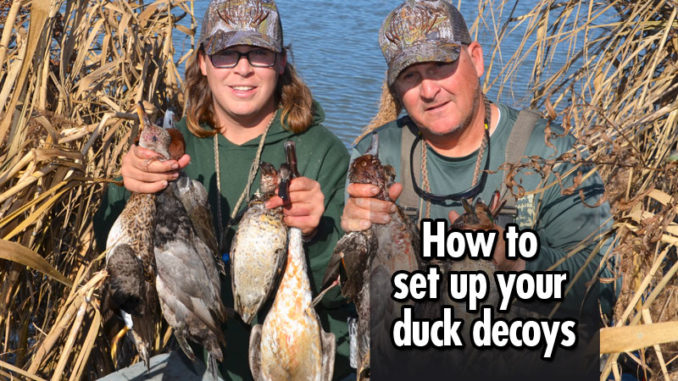
Dekes are probably the most important controllable factor for the average hunter. Here’s how to set ‘em up — so you can shoot ‘em down.
Creighton Ward has a big problem with ducks: He can’t shoot enough of them.
And time is a big factor. But it’s amazing he can hunt at all considering all the irons he has in the fire.
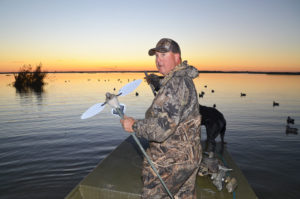
The 51-year-old is managing partner of Acadian Landscaping of Louisiana, sales manager for the Louisiana Division of American Tank and Vessel and owns Southern Exposure Inland Fishing Charters out of Buras with Tim Anderson. Finally, he’s partners with Victor Bergeron (Southern Exposure’s lead captain) on a belt-mounted drink holder called a Hip Huggie, as well as a newly designed camouflage clothing pattern.
Incredibly, he still averages hunting 40 days a season. “My passion is waterfowl, anything with wings,” he said in a colossal understatement.
He has leases in both North and South Louisiana. I asked why more than one. “If I could have 100, why not?” he shrugged. “My wife asks, ‘You have another one?’ My reply — ‘Well, I can’t pass it up.’
“Duck hunting is a family tradition. My grandfather Pat Pier handed it down to me. At 12 years old, my daddy finally let me go with him. He was a hard-ass; he would make me cry. But I loved the outdoors so much and he was my only outlet to do it.
“I brainwashed my son Collin at an early age. He shot his first duck at 4 ½ years old. He’s 21 now. The most days we’ve hunted together is 47 out of 60.”
Ward prides himself in the attention he pays to his decoys, probably the most important controllable factor for the average hunter.
He ranks being where the ducks want to be as the most important part of success, followed by concealment, then decoys and lastly, calling.
“For the average person, being where the ducks want to be isn’t an option anymore. Waterfowl leases that used to be sections (640 acres or one square mile) are now broken down into leases on individual ponds.
“Concealment falls to third because it doesn’t do any good to be concealed if you aren’t where the birds want to be, or you can’t bring them into range. Of course you still have to be hidden in any case.”
So attractants — decoys, are next most important.
Decoy selection
In what seems to be an obvious rule (even though it’s ignored more than honored), Ward recommended using a species mix that matches the local bird population. Hunters commonly hunt over mallard decoys simply because they are the easiest ones to find in stores.
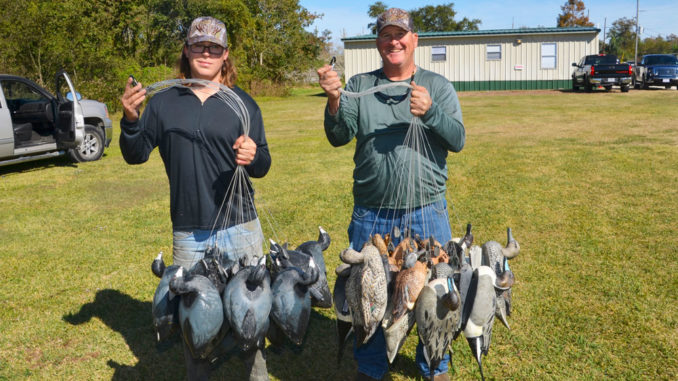
On his Plaquemines Parish lease, he uses a decoy spread featuring gadwall, pintail, wigeon, green-winged teal, blue-winged teal and coots. He doesn’t use diver duck decoys because in most situations he prefers not to shoot them.
In Northeast Louisiana, his decoy choice is entirely different. Sixty of 75 decoys that he typically uses there will be mallards.
“Brands are pretty important too,” he noted. “I like Greenhead Gear, but the up-and-coming brand is Avian-X. Realism is important. If you are going to go through all the effort and expense of duck hunting, why skimp on decoys?
“I see guys using decoys that have been handed down generations — sun-bleached and paint worn or knocked off. A live duck is vibrantly colored, so decoys should be colorful. But they shouldn’t be shiny. A sculpted decoy is not as shiny as a smooth one.”
Ward always uses weighted-keel decoys for two simple reasons.
“It is a big inconvenience to have to set every decoy in place. You can’t throw water-keel decoys. And water-keels also drain water all down your arm — a big problem when it’s cold.”
As for size, with the exception of a few pintail decoys, Ward uses standards for ducks. Where he does use magnums is with coots. “I feel that they look more realistic than standards,” he explained.
Numbers
“I like to use 60 to 80 decoys year-round, both in North and South Louisiana,” Ward said. “It’s largely a space issue — room in the boat. If I had room, I would hunt with 150.
“I love my teal decoys. They take up less room, so I can set more decoys to keep my numbers up. I will usually use two dozen teal decoys.
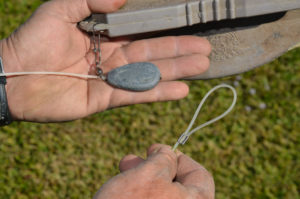
“One thing that bigger spreads do is present a temptation to leave decoys out between hunts. These decoys will weather and wear. And birds in the area get used to the decoys being in the same place and are not as attracted to them.
“I understand that new fronts bring in new birds. But the new birds quickly learn from the old birds.”
Ward doesn’t agree with the oft-recommended tactic of reducing decoy numbers to give late-season birds a new look. “I wonder if the hunters doing this are just getting lazy late in the season,” he pondered. “I think confidence is in numbers all season long.”
Handling
Handling large numbers of decoys is much easier if a method that reduces tangling and doesn’t requiring wrapping lines is used. Ward’s preference is for using a Texas rig. The rigs are built with large-diameter monofilament line.
A large egg sinker is hammered onto one end of the line. The line is then passed through the eye of a large swivel of a snap swivel (that is in turn snapped onto the decoy) and a loop is crimped on the other end.
After a decoy is picked up, its weight is slid up the line to rest next to the decoy’s body and its loop is snapped into a carabiner clip. As more decoys are picked up, their loops are also snapped in the clip until a manageable number are joined together.
Decoy care
Ward said washing decoys is important. “I try to do it every other weekend trip,” he said.
“Don’t hesitate to throw away decoys every four or five years. To keep worn out or beat up decoys is just ignorance,” he said, mincing no words. “Re-painting decoys is smart too, if hunters have time to do it.”
Confidence decoys
The use of confidence decoys begins and ends with coots for Ward. “l use coots instead of just more duck decoys so I can replicate a natural situation — within reason. Obviously, I am not going to put out 2,000 coot decoys.
“I can’t tell you how many times I have jumped six gray ducks out of 24 coots while running my boat. Time on the water is what led me to use coots.
“I use 36 coots and set them a little apart from the ducks, in a loose pattern rather than tight that makes them look like they are more in number.”
Dekes in motion
“I am beginning to second-guess the use of spinning wing decoys. My level of confidence in them is about even with my lack of confidence. I think there is a time and place to use them, rather than as an everyday thing.
“I like them when I am set up in heavy vegetation where it’s hard for the birds to see my decoy spread. Also, in areas where hunter concealment is limited, I feel that they can divert the birds’ attention away from the hunter.
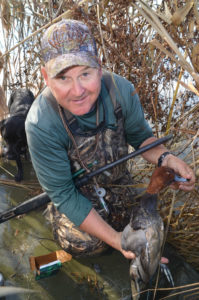
“And they are more useful on large bodies of water, 100 acres or more. Spinning wing decoys do better in sunny conditions, where ever they are used.”
But Ward no longer uses large duck spinning wing decoys, opting instead for smaller, dove versions. The batteries are easier to deal with, but most of all, the flash is more limited.
“I like to set them as low to the water as possible and I place them on the inside edge of the decoy spread. Even if birds flare at the last minute because of the flash, they are still within gun range.”
Ward generally uses spinning wing decoys less and less as the season progresses, unless he’s in open water. But he has used other motion decoys.
“I have been using Wonderduck decoys as long as spinning wing decoys. I call them flash-and-splash decoys and in no-wind situations, I like them more.
“Mojo Mallard Machines are amazing, but they are a pain in the butt. You have to tote a car battery and run a wire from the battery to the set up. You better remember where the wire is, too, when you run your boat.
“Of course, you can still use a homemade jerk string like we all started with. They are still effective, but less convenient than spinning wing decoys.”
Proper placement
Like many other hunters, Ward feels that duck behavior has changed. “With the pressure on birds now, coupled with their natural wariness, I think that ducks now tend to land on the outside edge of the decoy spread. This is especially true for gray ducks.
“So for me, the decoys can never be too close. I place the closest ones 20 feet from the blind and the furthest ones 15 yards from the blind. Because of this tendency for ducks to light further out, never let birds set in ponds. Shoot to scare them out.
“I set my coot cluster separate from the duck decoys. If you know what direction the ducks will likely be coming from, set the ducks to intercept the birds first and then the coots behind them.”
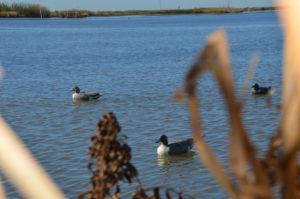
Ward is particular about not having to face the sun. He always wants the rising sun to his back and will actually place his decoys on the up-wind side of the blind to avoid facing the sun. This, of course, forces the birds to go over the blind to alight in the decoys. “I back-shoot them,” he said with an evil grin.
In South Louisiana marshes he will mix gadwalls, wigeons and pintails, but he always keeps his teal and coots separate. In North Louisiana, he will separate his mallard decoys from the coots and gadwalls. He calls this a “massive splash of mallards, with some mixed species on the edges.”
No matter where he sets up, he always leaves an open landing zone with just a couple of dekes there. In his experience, he says ducks will almost always land in the open zone or on the outside edge of the decoys.
“Do not use Vs and Js,” he said emphatically. “They are not necessary. It is important to adequately space decoys apart to make them look natural. Nothing aggravates me more than decoys being placed so close that they bang into each other.”
Salvinia and surface drives …
Duck hunters are a tradition-bound bunch. They want to pass the sport along to the next generation, so it’s only natural that they fret and worry over threats to what they so dearly love.
Creighton Ward is no different. He has two overriding concerns now. One is expected; the other is a surprise.
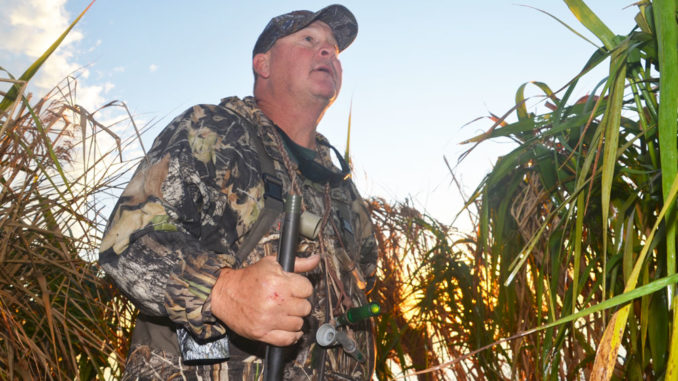
Vegetation issues concern Ward.
He calls invasive salvinia “absolutely horrible.” He ticked off areas that were “fantastic waterfowl areas” before they were infested with the weed and heavily impacted by it: the White Lake area, Bayou Bienvenue and the Intracoastal City area.
“It blankets all the natural vegetation,” he spat.
“It looks like a garden, not a pond,” added son Collin.
“And it decimates an area,” the senior Ward went on. “It voids it of waterfowl. I’ve personally seen it go from thousands of ducks to absolutely nothing.”
The other vegetation issue that worries Ward is the current mealy bug attack on roseau canes on the Mississippi River Delta.
“In the last year or two, certain stands of roseau cane have been decimated. The canes are the only thing holding the Delta together in places. Their rhizomes lock together, forming dense mats.
“The canes enclose ponds and marshes protecting them. If you lose them, you lose the Delta’s wintering waterfowl habitat, as well as its estuarine fishery.
“Our main concern is the loss of habitat, but roseau canes are also important for hunting cover. I can build a blind out of anything, but a lot of hunters down here, especially on public land, hide themselves in canes.”
He moved on — cautiously, to his other concern: surface drive engines.
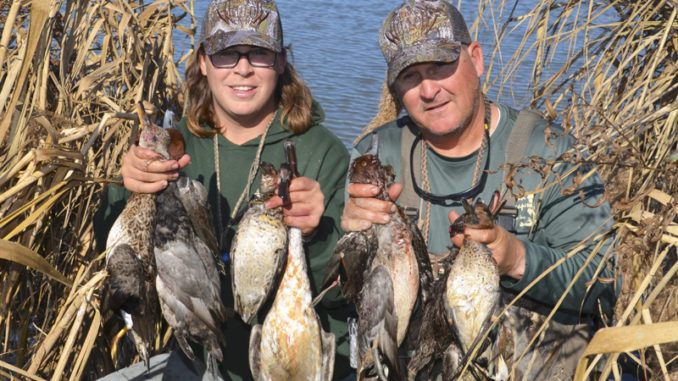
“It sounds like a motor speedway during duck season in the Plaquemines Parish marshes. The birds are constantly pressured. After they hunt, people ride and inspect other areas.
“It makes duck hunting unpleasant because all you hear is motor noise. They tear up the marsh and scare birds.”
“It makes ducks more wary and harder to work,” piped in Collin. “It creates more passing shots instead of in-your-face shots.”
“Surface drives make it easy for people to access your lease when you are not hunting,” the elder Ward said. “They ‘check things out’ on your lease and they run the lease to move birds so that their fellow hunters get more shooting.
“It doesn’t do much good for leaseholders to rest their leases with off-days or prohibit afternoon hunting.”